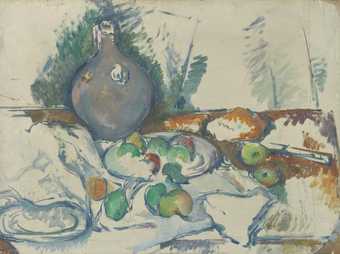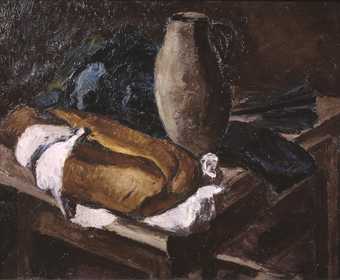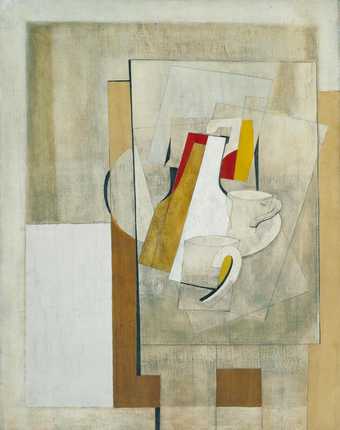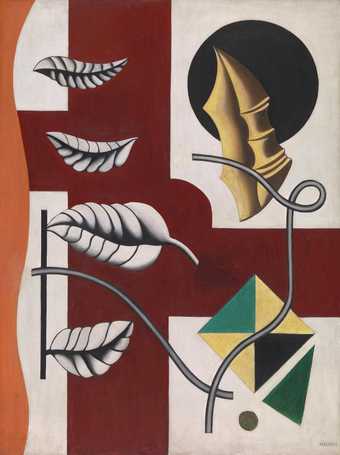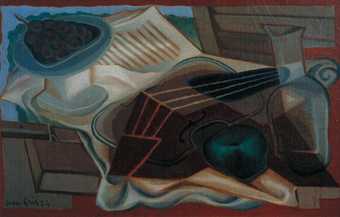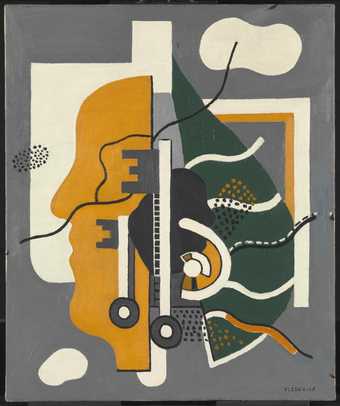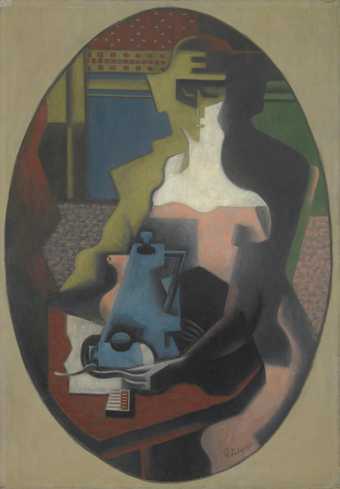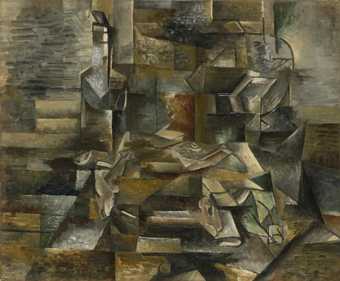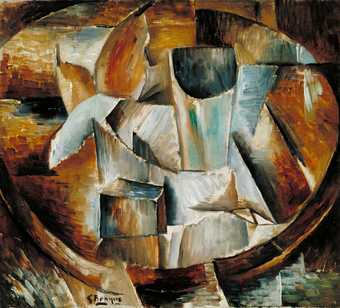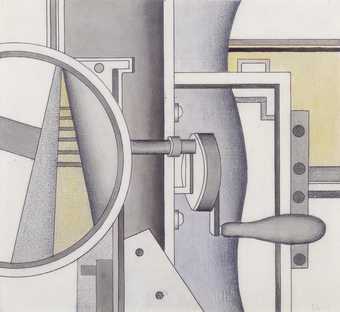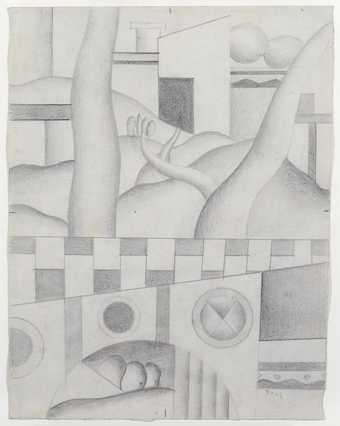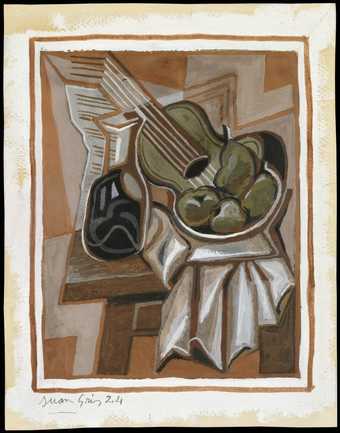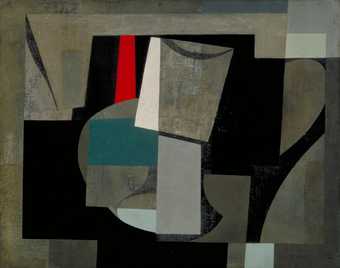
In Tate Modern
- Artist
- Fernand Léger 1881–1955
- Original title
- Nature morte à la chope
- Medium
- Oil paint on canvas
- Dimensions
- Support: 923 × 604 mm
frame: 1075 × 748 × 70 mm - Collection
- Tate
- Acquisition
- Purchased with assistance from the Friends of the Tate Gallery 1976
- Reference
- T02035
Summary
Still Life with a Beer Mug 1921–2 is a rectangular, vertically oriented oil painting by the French artist Fernand Léger. The painting depicts a traditional Bavarian-style beer mug in the forefront of the composition sitting on a simple, square wooden table which is surrounded by everyday lunch items, such as butter pots, a knife and a fruit plate. The table and beer mug are painted in vibrant colours including yellow, orange, red and blue, while the surrounding elements are executed in a contrasting palette consisting of black, grey and white, with some patches of colour. The colourful table is juxtaposed against a flat geometric kitchen backdrop, represented by a black and white diamond-patterned floor and a gridded kitchen wall and window frame. The flat geometry of the kitchen is interrupted by a dark blue curtain, which, like the beer mug and its surrounding objects, is rendered in a slightly more naturalistic style due to the employment of light and shade.
Léger made Still Life with a Beer Mug by executing a preliminary graphite sketch and transferring it onto a primed canvas. Evidence of Léger’s initial sketch can be seen in the graphite ‘squaring up’ grid-lines visible at the edge of the canvas and in areas where the paint has been more thinly applied. Although Léger painted the work using thick oil paints, there are no areas of impasto and little evidence of the artist’s brushstrokes. Preferring a flat graphic surface in his paintings in the 1920s, this brush-mark-free technique is evident in other works from the period, such as Le Grand Déjeuner 1921 (Museum of Modern Art, New York) and Femme à genoux 1921 (Denver Art Museum, Denver). The words ‘Nature Morte’ (‘still life’), ‘F. Léger’ and ‘Etat Definitif’ (‘final state’) are hand-painted and underlined in capital letters on the back of the canvas along with the date ‘1921’. A circle has also been added in paint around the words ‘Etat Definitif’.
According to Tate curator Ronald Alley, several different versions of Still Life with a Beer Mug are in existence. There is also photographic evidence that Léger reworked the painting after he submitted it to Galerie Simon in Paris in 1922 (see Alley 1981, p.418). A pencil study for Still Life with a Beer Mug dated 1921 forms part of the Lydia and Harry Lewis Winston collection in New York. However, this study has ‘less patterning and is slightly more realistic in treatment’ (Alley 1981, p.418). Alley has also recorded that ‘a smaller sketchier preliminary version’ of the painting, much closer to the final version, appeared in the Burlington Magazine in February 1972. This version is not as long or narrow in format and the diamond floor pattern is painted much more irregularly (see Alley 1981, p.418).
Deeply affected by his experiences on the front line during the First World War, Léger abandoned the form of cubism he had been pursuing up until 1914 and turned instead to what he called a new ‘reality of objects’ (see Peter de Francia, Fernand Léger, New Haven and London 1983, p.31). Art historian Robert Herbert has noted that Léger’s move away from the severe abstraction of his pre-war compositions and his return to classical subjects (such as the still life and the nude) was in part connected to a broader cultural movement in France during the 1920s that has been called the ‘Return to Order’. ‘By taking up a theme sanctioned by tradition,’ Herbert notes, Léger ‘hoped to integrate art history, as well as past time, into the present’ (Robert Herbert, Léger’s Le Grand Déjeuner, exhibition catalogue, Minneapolis Institute of Arts, Minneapolis 1980, p.13). ‘The Beautiful is everywhere’, acknowledged Léger in 1924, ‘perhaps [more so] in the arrangement of your saucepans on the white walls of your kitchen than in your eighteenth-century living room or in the official museums’ (quoted in Sophie Lévy (ed.), A Transatlantic Avant-Garde: American Artists in Paris, 1918–1939, Berkeley 2003, p.34).
Further reading
Ronald Alley, Catalogue of the Tate Gallery’s Collection of Modern Art other than Works by British Artists, London 1981, pp.417–8, reproduced p.417.
Simon Wilson, Tate Gallery: An Illustrated Companion, revised edn, London 1991, p.168.
Georges Bauquier, Fernand Léger: Catalogue Raisonné 1920–1924, Paris 1992, reproduced p.417.
Judith Wilkinson
April 2016
Supported by Christie’s.
Does this text contain inaccurate information or language that you feel we should improve or change? We would like to hear from you.
Display caption
Léger believed that art should be accessible to all. He moved away from pure abstraction and towards the stylised depiction of real objects. He put great emphasis on order, clarity and harmony. In the 1920s, he developed an interest in geometric compositions. This painting shows a relatively naturalistic still life of a workman’s lunch on a table. The primary colours of the mug and tablecloth contrast with the black and white patterns in the background
Gallery label, June 2021
Does this text contain inaccurate information or language that you feel we should improve or change? We would like to hear from you.
Catalogue entry
Fernand Léger 1881-1955
T02035 Nature Morte à la Chope
(Still Life with a Beer-Mug) 1921-2
Inscribed 'F. LÉGER' b.r. and 'NATURE-MORTE | F. LEGER. (ETAT | DEFINITIF) | 1921' on back of canvas
Oil on canvas, 36 1/4 x 23 5/8 (92 x 60)
Purchased at Christie's (Grant-in-Aid), with the aid of the Friends of the Tate Gallery 1976
Prov:
With Galerie Simon, Paris (purchased from the artist); Dr G.F. Reber, Lausanne, 1926; with Frau Walter Feilchenfeldt, Zurich, 1956; with Marlborough Fine Art, London, 1958; Gustav Zumsteg, Zurich, 1961; Zumsteg sale, Christie's, London, 6 April 1976, lot D, repr. in colour
Exh:
FernandLéger 1881-1955, Haus der Kunst, Munich, March-May 1957 (32) as 'Küchenstilleben' 1921; Kunsthalle, Basle, May-June 1957 (29); Kunsthaus, Zurich, July-August 1957 (37); Some Aspects of 20th Century Art, Marlborough Fine Art, London, July-August 1961 (19, repr.) as 'Nature Morte dans la Cuisine'; Fernand Léger, Musée Cantini, Marseilles, July-August 1966 (30) as 'La Chope'; Chefs-d'Oeuvre des Collections Suisses, Orangerie des Tuileries, Paris, May-September 1967 (236, repr.); A la Rencontre de Pierre Reverdy et ses Amis, Fondation Maeght, Saint-Paul, March-May 1970 (341, repr.) as 'Nature Morte à la Chope'; Musée National d'Art Moderne, Paris, June-July 1970 (341, repr.); FernandLéger, Grand Palais, Paris, October 1971-January 1972 (72, repr.)
Repr:
E. Tériade, Fernand Léger
(Paris 1928), pl.47 (first state); Douglas Cooper, Fernand Léger et le Nouvel Espace
(London-Geneva-Paris 1949), p.93 as 'Nature Morte dans la Cuisine (1922)' (first state); The Tate Gallery 1976-8
(London 1978), in colour on cover
This picture is inscribed on the back 'Etat définitif [i.e. final state] 1921,' but appears in the Galerie Simon records as a work of 1922. It was acquired by the Galerie Simon at the same time as nine other pictures and five crayon drawings by Léger, and the whole series is dated in their records 1922, except one painting called 'Two Fishermen' which is dated 1921. This suggests that the year of execution was fixed with some care for each work.
The original Galerie Simon photograph, taken when the picture was first acquired, shows several minor differences, which make it clear that the picture was subsequently reworked, probably soon afterwards. The criss-crossed rectangle towards the bottom left originally had a smaller disc at the centre which appears to have been enlarged and painted a different colour; the black disc immediately above it was made more circular; and the vertical area towards the top left, with two circular patches one above the other, originally had two double horizontal stripes across it which were afterwards overpainted in white (but are now beginning to show through again).
There is a pencil study for this composition measuring 38 x 25.4 cm and dated 1921 in the Lydia and Harry Lewis Winston collection (Dr and Mrs Barnett Malbin, New York), which has less patterning and is slightly more realistic in treatment. Among other differences, there are handles on the two drawers and the diamond pattern on the floor is inclined sideways (suggesting recession) instead of being aligned vertically parallel to the picture plane; and the sides and top of the composition are treated with an austere simplicity, instead of being crowded with contrasting patterns.
There is also a smaller and sketchier preliminary version (repr. Burlington Magazine, CXIV, February 1972, p.lv) in oil on canvas, 65 x 46cm, which is much closer to the final state. However it is not so long and narrow in format, the diamond pattern on the floor is more irregular and extends down the lower part of the left-hand side and there is very little white along the bottom. In addition (to cite the principal differences), it lacks the lower black disc on the left-hand side and the blue rectangle above it with the undulating line and the three spots, but has a row of dots along the dark horizontal stripe towards the top right.
In painting the final version and again in his later modifications to it, Léger made a number of adjustments to the distribution and balance of the contrasting patterns, so that the composition became progressively more and more precise and vibrant. This enhanced those features which appear to anticipate, to a degree exceptional in his work, both the Op art of Vasarely and the Pop art of Roy Lichtenstein.
The beer mug appears to be of a type especially popular in Bavaria.
Published in:
Ronald Alley, Catalogue of the Tate Gallery's Collection of Modern Art other than Works by British Artists, Tate Gallery and Sotheby Parke-Bernet, London 1981, pp.417-18, reproduced p.417
Explore
- abstraction(8,615)
-
- from recognisable sources(3,634)
-
- man-made(999)
- non-representational(6,161)
-
- geometric(3,072)
- formal qualities(12,454)
-
- cubist space(86)
- pattern(358)
- food and drink(980)
-
- drink, beer(34)
- fruit, apple(85)
- table(754)
You might like
-
Georges Braque Glass and Plate of Apples
1925 -
Paul Cezanne Still Life with Water Jug
c.1892–3 -
André Dunoyer de Segonzac Still Life with a Cabbage
1919–20 -
Ben Nicholson OM 1945 (still life)
1945 -
Fernand Léger Leaves and Shell
1927 -
Juan Gris Violin and Fruit-Dish
1924 -
Fernand Léger Keys (Composition)
1928 -
Jean Metzinger Woman with a Coffee Pot
1919 -
Claude Venard Still Life
1955–6 -
Georges Braque Bottle and Fishes
c.1910–12 -
Georges Braque Glass on a Table
1909–10 -
Fernand Léger Mechanical Elements
1926 -
Fernand Léger Trees
1923 -
Juan Gris Still Life with Guitar
1924 -
Ben Nicholson OM 1934-6 (painting - still life)
1934–6


